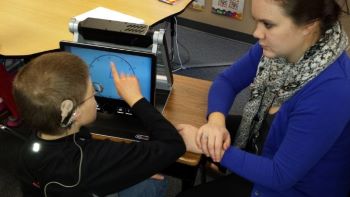Maximizing the Use of Hearing and Vision
There are many ways to maximize hearing and vision for a child with deafblindness.
These include medical devices like glasses and hearing aids, assistive technology, and individualized educational accommodations. The foundation for determining the best devices and accommodations for a particular student is a careful, thorough assessment.
Educational personnel play an essential role in helping students use accommodations and devices and making observations about how well they work. Making the most of (maximizing) any vision or hearing that a student with deafblindness has, will help them be as successful as possible in school and life.

Introductory Resources
Learn More
We must take every opportunity to ensure that we are maximizing the use of every avenue for learning and preserving whatever residual senses exist (Miles & Riggio, 1999, p. 35).
Reference
Clyne, M., Wolfe, J., Blaha, R., Hertzog, T. (2015, September). Maximizing vision and hearing. In National Center on Deaf-Blindness, Open Hands, Open Access: Deaf-Blind Intervener Learning Modules. National Center on Deaf-Blindness.
Miles, B., & Riggio, M. (1999). Understanding deafblindness. In B. Miles, & M. Riggio (Eds.), Remarkable conversations: A guide to development meaningful communication with children and young adults who are deafblind (pp. 21-37). Perkins School for the Blind.
KEEP EXPLORING